|
MAIN PAGE
> Back to contents
Historical informatics
Reference:
Voronkova D.S.
The experience of computerized content analysis of articles of the journal "Bulletin of Finance, Industry and Trade" for 1917
// Historical informatics.
2023. № 3.
P. 85-106.
DOI: 10.7256/2585-7797.2023.3.43663 EDN: XELKNL URL: https://en.nbpublish.com/library_read_article.php?id=43663
The experience of computerized content analysis of articles of the journal "Bulletin of Finance, Industry and Trade" for 1917
Voronkova Dar'ya Sergeevna
PhD Candidate, Section of Historical Informatics, History Department, Lomonosov Moscow State University
119192, Russia, g. Moscow, ul. Lomonosovskii Prosp., 27 korp.4, kab. G-432

|
dasevo@yandex.ru
|
|
 |
Other publications by this author
|
|
|
DOI: 10.7256/2585-7797.2023.3.43663
EDN: XELKNL
Received:
29-07-2023
Published:
12-10-2023
Abstract:
The subject of the research is the materials of articles of the journal "Bulletin of Finance, Industry and Trade" for 1917 – the leading printing body of the Ministry of Finance. The methodological basis of the article was a computerized content analysis, which made it possible to fully reveal the information potential of the source. Special attention is paid to the construction of a representative system of semantic categories and indicators based on the frequency dictionary, which revealed thematic priorities and semantic accents in the entire array of issues of the "Bulletin ..." in the specified year. The analysis of the frequency of occurrence of the created categories (including joint ones) in dynamics by quarters is carried out. The interrelationships of the categories make possible conclusions based on the argumentation of the authors of the journal articles. The materials of Vestnik ... have previously attracted the attention of scientists, but only now, with the help of computerized content analysis, a hidden layer of information contained in it has been introduced into scientific circulation, which is the scientific novelty of the work. The content analysis showed that the journal "Bulletin of Finance, Industry and Trade" reflected the situation and processes in the socio-political sphere in the country and abroad that developed in the economy at the turning point of 1917, unfolding against the background of the ongoing First World War. The main core of the constructed system of semantic categories turned out to be financial issues in close connection with the industrial, trade and tax spheres, as well as problems caused by the war and growing in the economy and society.
Keywords:
Bulletin of Finance, economic processes, Media, content analysis, semantic categories, dynamics, MAXQDA, official press organ, February Revolution, history of Russia
This article is automatically translated.
You can find original text of the article here.
The article is devoted to the results of a computerized content analysis of the articles of the journal "Bulletin of Finance, Industry and Trade" for 1917. The journal is in many ways an indispensable source of economic information, including in the field of state financial policy, international trade, taxation, etc. In the revolutionary year 1917, the pages of the magazine reflected the economic processes taking place in Russia against the background of the ongoing World War. Content analysis is a well-established and at the same time promising method of historical research (including periodical printing has been studied with its help for a long time and fruitfully) [1]. However, the named journal has not previously become the object of content analysis. At the same time, he attracted the attention of historians, and there are new works in which he is a source base [2; 3; 4; 5; 6; 7]. "Herald..." as a source One of the defining source characteristics of the mentioned journal is its official status as a printing body of the Ministry of Finance. By 1917, it had been published for 32 years (since 1885, and before that there was a direct predecessor – the Index of Government Orders for the Ministry of Finance, published in 1865-1884). In some sources, the year of the beginning of the publication of the "Bulletin" is indicated in 1883. Perhaps the discrepancies are related to the fact that in 1885 the journal was reorganized. The editorial board received at least formal independence, having been allocated from the staff of the Ministry of Finance, and its budget. Such changes are so important that sometimes 1885 is taken as the year of the magazine's foundation. However, in the process of reorganization, even the editor–in-chief was not replaced - both in the "Index ..." and in the "Bulletin ..." this position was held by A. K. Veselovsky. Let us stop at 1884 as a compromise date for the beginning of the publication of the "Bulletin ...". There are a number of justifications in favor of this version, including articles in the Brockhaus and Efron Encyclopedic Dictionary (https://www.booksite.ru/fulltext/1/001/007/020/20375 .htm; https://www.booksite.ru/fulltext/1/001/007/104/104187.htm ; https://www.booksite.ru/fulltext/1/001/007/020/20375.htm ), as well as bibliographic descriptions of the journal in the RNB (https://www.booksite.ru/fulltext/1/001/007/020/20375.htm – It seems to us that here, with the exception of the first line, in which "Bulletin..." dates from 1865, the ratio of "Index..." and "Bulletin ..." is correctly described) and in the NEB (https://www.booksite.ru/fulltext/1/001/007/020/20375.htm ). It is noteworthy that in the "white" Omsk, a short-term attempt was made to "reanimate" the "Bulletin ...", publishing it once every two weeks. This, in particular, is evidenced by one of the surviving April issues of the "Bulletin ..." for 1919 with the indication: "The journal is published by the Ministry of Finance of the Russian Government." (https://www.booksite.ru/fulltext/1/001/007/020/20375.htm). The initiator of the publication of the new magazine was initially the Minister of Finance N. H. Bunge, and in fact this event was sanctioned by Emperor Alexander III himself. Article 10 of the "Rules on the taxation of commercial and industrial enterprises with an additional fee (percentage and layout)", approved on January 15, 1885, regulates the procedure for publication in the "Bulletin ..." extracts from minutes of general meetings of joint-stock companies and partnerships, as well as balance sheets and annual reports of such associations [8]. The publication was mandatory, besides it was paid. The publication of the "Bulletin..." became a logical continuation of the tax reforms of the 1880s. Being the mouthpiece of government policy, Vestnik ... provided the audience with materials carefully selected by the editorial board (among the authors there are many, in particular, leading economists of their time). On the website of the publishing house "Budget", quite a lot of attention is paid to the circumstances of the appearance of the "Bulletin ...": "... a new magazine was created, which became known as the "Bulletin of Finance, Industry and Trade". <...> The widespread use of telegraphic communication led in 1894 to the formation of a special telegraph department in the editorial office of the Bulletin. The quality of work, accuracy and timeliness of receipt of commercial and other telegrams caused an ever-growing demand for the services of the department from other periodicals and individuals. After all, although at that time there was already a "Russian Telegraph Agency", it was not engaged in commercial information. Under these conditions, the telegraph department, constantly developing, in 1902 was transformed into a separate institution – the "Trade and Telegraph Agency". The management and management of the agency continued to be carried out by the editorial team of Vestnik, and its editor was appointed director of this organization. The quality of the agency's work was noticed by the press. And soon many periodicals switched to him for information service. Foreign telegraph agencies concluded agreements with him on the exchange of telegrams. In 1904, it was decided to transform the "Trade and Telegraph Agency" into the "St. Petersburg Telegraph Agency".[9]. Thus, the editorial board of the "Bulletin ..." based its work on the principles and technologies advanced for its time, contributed to the development of the telegraph network and gave rise to the publication of a number of print media, such as the "Trade and Industrial Newspaper" and "Russian Economic Review". At the end of the quarter, a "Systematic list of articles" was published, but in 1917 only two were published – for the first and second quarters. Research methodology As noted above, content analysis is successfully used as a method of analyzing text sources and, in particular, the historical press. The software that made it possible to carry out a computerized content analysis of the materials of an array of articles from the issues of the "Bulletin ..." of 1917 was the MAXQDA program [10]. The work uses the MAXQDA version – MAXQDA 2022. Development of a system of categories and analysis of their occurrence frequencies
After repeatedly reading the journal articles, converting the source file into recognized electronic text and importing this text into the MAXQDA program, a frequency dictionary was created in the MAXDictio module. Based on the most common words, indicators were identified, which were consolidated into a system of categories. The text is then indexed using the auto-coding option with a dictionary. Indexing in content analysis is the markup in the text of segments where indicators of the corresponding categories meet. Indexing was based on indicators for which only the root bases of words were set. In total, 14 categories were constructed (all of them, with the exception of the "countries" category, are single-level, and the latter includes opposing and neutral states, and the composition of the corresponding blocks was formed taking into account the realities of 1917, therefore, for example, Italy was on the side of the Entente). A number of the author's articles highlight the most important problems for the journal and analyze their topics [11; 12; 13]. The results are presented in the following table (Table 1): Table 1. Semantic categories of texts and indicator words | Category name | Indicators | | finance | finance, value, price, price, bank, money, money, money, banker, balance, banknotes, gold, silver, currencies, deposit, capital, treasury, sums, budget, redemption, check, loan, ipote, loans, collateral, mortgage, loan, loan, bond, coupon | | trading | bidding, export, import, goods, duties, customs, import, import, export | | industry | industrial, plant, productions, enterprises, factories, factories, industries, oil, mines, sugar, steel, foundry, syndicate, cellulose, woodworking, chemical, machinery, weaver, leather, coal, handicraft, trust, manufactories, coal, mining | | war | army, airplane, blockade, bombs, battles, brusilov, military, warrior, wars, troops, enemy, enmity, enemy, hero, heroes, demobilized, volunteer, captured, conflict, mobilizat, mobilizov, guns, weapons, battles, grenades, officer, pike, patriot, patron, victories, defeated, guns, push, soldier, allied, arrows, wounded, combat-ready, armed, fighting, hospital, enemy, trench, cannon, front, airship, air | | political sphere | minister, minister, emperor, supreme, revolutionaries, governments, deputy, autocrat, founder, states | | socio-economic sphere | strikes, strikes, strikes, demonstrations, strikes, striking, bread, devastation, labor, supplied, foodstuffs, crisis, sequestration, apartments, dwellings, birth rate, mortality, population, earnings, insurance, refugee, disabled, salaries, card | | taxes |
tax, excise, levy, levied, tariff | | legal field | law, law, parliament, reform, law, amendment, amendment, law, codification | | agricultural industry | agriculture, grain, plough, millet, barley, cotton, cotton, cotton, beets, livestock, fish, forest, land, agriculture, cattle, plow, meadow, pastures | | joint stock business | stocks, stocks, shares, stock, stock, stock exchanges, securities, promissory notes, currencies | | transport | transport, ship, steamer, wagon, ships, ships, railway, roads, road, road, roads, transportation, cargo, passenger, sailor, coaster, train | | mail and telegraph | telegraph, telegram, taxi, express, correspondents, letters, letters, parcels, parcels, forwarding | | resettlement policy | colonized, resettled, colonist, agrarian | | countries | | | Entente and Allies | English, French, Japanese, State, Brazilian, Italian, Indie, Serbian, Greek, Romanian, Australian | | The Triple Alliance , etc . | Herm, Austr, Hungarian, Bulgarian | | neutral |
Swiss, Swedish, Persian, Argentine, Swiss, Holland, Netherlands | The unit of account is the offer, and the unit of analysis is the identified category. Tables of word frequencies have been compiled for the journal as a whole (words that do not carry a semantic load are excluded using a stop list - a list of service words that are not subject to analysis). In MAXQDA, it is possible to create a word cloud (visualization of a frequency dictionary), but a cloud of category codes will be more informative for us (Fig. 1). 
Fig. 1. Code cloud It can be seen that the most common category is "finance", followed by "trade", "industry", "war" and "political sphere". This is also confirmed in dynamics if we present the categories by frequency of occurrence for each quarter of 1917 and display the result in the form of a so-called heat map (with this graphical representation, the warmest shades correspond to the most common categories, and the lower the frequency, the colder the color; Fig. 2): 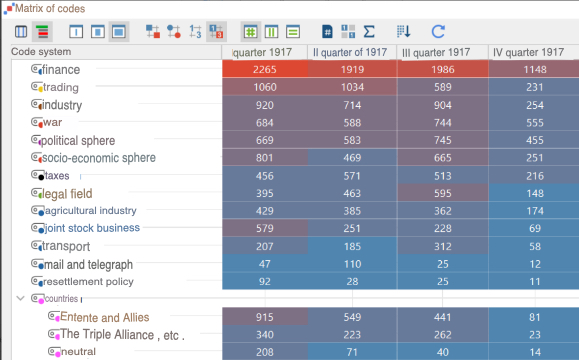
Fig. 2. Heat map of the frequency of occurrence of categories The analysis of quarterly indicators is chosen for two reasons. Firstly, if you do not combine the 43 issues of the Bulletin ... into any groups, the final tables will be too cumbersome and difficult to understand. Secondly, if the numbers are combined monthly, there will be a question with a double number 19-20: it is dated May 14 (27) and May 21 (June 3), 1917, which means that, being a single one, it would formally have to fall into different months, and it is impossible and incorrect to separate its materials. Thus, the only option is to combine the numbers into groups of documents by quarter. The first quarter – numbers inclusive from 1 to 13-14 (double), the second – from 15 to 26, the third – from 27 to 38 and the fourth (incomplete) – numbers 39-43. We see that the "finance" category tops the list throughout the year. The "trade" category has been among the main ones for three quarters, and only in the fourth interest in it is noticeably falling, giving second place to the "war" category. For the first quarter, the three categories are closed by "industry", in the second – "trade", in the third – "political sphere" ("industry" at the same time comes in second place), and in the fourth, the last, in which the publication of the magazine ceased, the third place is shared with the political sphere by the category "war". Despite such a wide range of issues discussed on the pages of the magazine, it is possible to outline something in common about why they received such attention. In our opinion, the unifying factor is the search for additional sources of state income, ways to solve the problems of supplying the population, getting out of the gradually escalating transport and fuel crisis and analyzing foreign experience in these areas. In order to more accurately identify the main categories and work with them in the future, we used a useful tool MAXQDA – "code coverage". This indicator for groups of documents (corresponding to the four quarters of 1917) was 87.6-91.7%. Such high values indicate the completeness of all stages of encoding the source text data. Let's look at the distribution of the frequency of occurrence of categories, provided that the values are rounded to tenths (the "percentage of total text" setting is selected, Fig. 3). 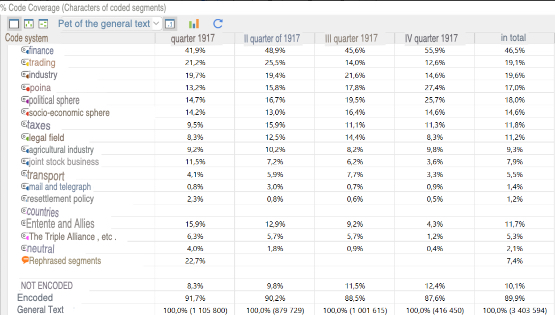
Fig. 3. The frequency of occurrence of categories is calculated using the "code coverage" function So, we can make the following list of the most common categories for 1917 as a whole: · "finance" (46.5%); · "industry" (19.6%); · "trade" (19.1%); · "political sphere" (18.0%); · "war" (17.0%); · "socio-economic sphere" (14.6%); · "taxes" (11.8%); · "legal field" (11.2%). It is for them that we will calculate and visualize the frequencies of joint occurrence below. Analysis of the frequency of joint occurrence of categories The MAXMaps module, which allows you to build informative graphs, is well suited for visualizing the frequencies of joint occurrence of categories. We are interested in the proximity of the codes (the user himself can set the necessary distance for the text of the document – for example, the fixed codes can be located in neighboring or one or two paragraphs from each other) and the intersection of the codes in the encoded segments. In the constructed graph, the maximum distance between codes in one paragraph is set by the proximity of categories. The result is shown in Fig. 4. The fatness of the lines is an indicator of the high frequencies of the common occurrence of categories, the frequencies themselves are indicated on these lines. The core of the graph consists of those categories between which the strongest connections are. 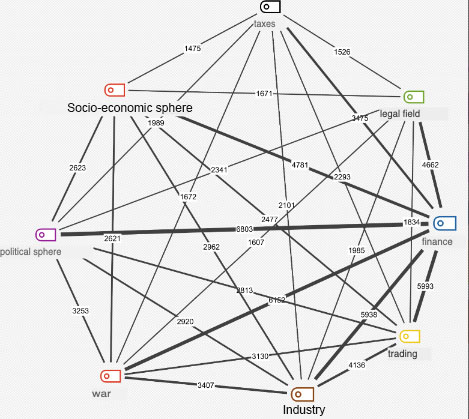
Fig. 4. Graph of frequencies of joint occurrence of categories by their proximity All the main categories shown in the graph are closest to the "finance" category. The paired values are as follows: · "finance" - "political sphere": 6803; · "finance" - "war": 6152; · "finance" - trade": 5993; · "finance" - "industry": 5938; · "finance" - "socio-economic sphere": 4781; · "finance" - "legal field": 4662; · "finance" - "taxes": 3475. In addition, the strong connection between the categories "trade" and "industry" is noteworthy (4136). Thus, financial issues clearly form the core of the entire content of the "Bulletin ...". They are most strongly associated with the political sphere, as well as the categories "war", "trade" and "industry", while the latter two are expected to be mutually close. MAXQDA helps to identify these hidden relationships. Let's focus on the structure of categories in more detail, analyzing each of the following graphs in Fig. 5-12 (these graphs are constructed based on the intersection of categories; in order not to overload the images, 10 categories intersecting with the central one are shown). 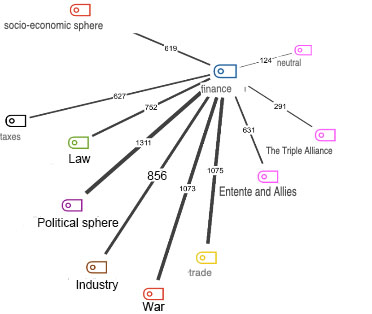
Fig. 5. Graph of co-occurrence frequencies for the category "finance" Finance for the authors of the "Bulletin ..." – mainly issues of money and check circulation, the budget, the State Bank, the foreign exchange market, etc. This explains the prevalence of links with the categories "political sphere", "trade", "war", "industry". Here is what B. Remez writes about the reasons for the preparation of monetary reform: "During the war under way, as in the previous historical epochs of shocks to the monetary system, quite a lot of articles have already appeared on the issue of the upcoming monetary reform. The original feature of modern projects is that they are mostly aimed not at returning to metal circulation, but at streamlining the existing paper and money economy" [14]. Wartime also left its mark on the financial sphere. A. N. Guryev notes on this occasion: "Modern war, with all the complex complex of phenomena generated by it, has already been certified by the whole world as unprecedented, unheard of, without any precedent in history. In accordance with this attestation, all previous views based on historical precedents have been subjected to a decisive revision. Only in one area we still have a historical stencil. This area is the paper and money economy generated by the war" [15]. 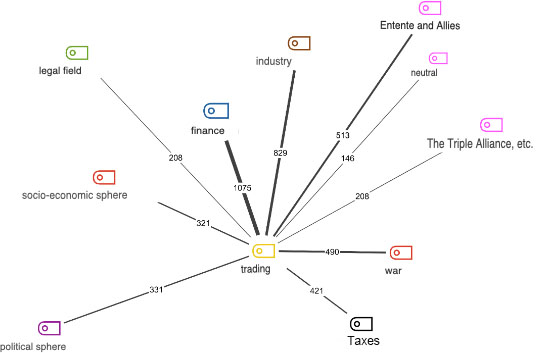
Fig. 6. Graph of co-occurrence frequencies for the category "trade" Figure 6 shows that the strongest relationship between the category "trade" and the category "finance". There are also noticeable links with the categories "industry", "Entente and allies", "war" and "taxes". The latter two are also not strange in this context: we are talking about the fact that, on the one hand, military spending needs to be replenished with proceeds from trade, and on the other, the question "where to get additional funds?" the authors of the "Bulletin ..." are trying to solve "at the junction" of the trade and tax spheres. 
Fig. 7. Graph of co-occurrence frequencies for the category "industry" The category "industry" (Fig. 7) is closely related to the categories "finance", "trade", "war", somewhat weaker – with socio-economic and political spheres. In general, this is the whole complex of the most important issues that are most closely considered on the pages of the magazine. 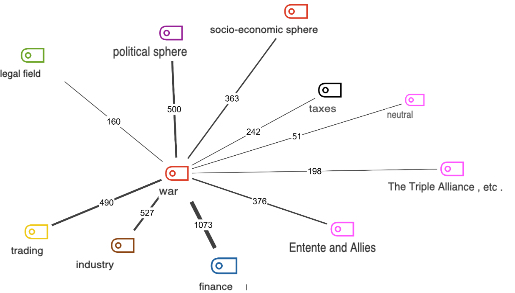
Fig. 8. Graph of co-occurrence frequencies for the category "war" In the case of the frequencies of the joint occurrence of the category "war" with other main categories (Fig. 8), an unobvious result can be noticed. The connection with the category "finance" is also the strongest here (war is always expensive!), followed by the categories "industry", "political sphere", "trade" by a large margin. But the links with the subcategories of countries (which, we recall, are divided into three blocks), although quite naturally bring the Entente and allies to the fore of them, are still not as strong as one might expect. This result reveals hidden information that is difficult to obtain by traditional methods.
It should be noted that, despite the above, the experience of the allies was covered in sufficient detail in the magazine. For example, in the 43rd issue of Vestnik ..., which became the last, there are also reflections on possible measures to restore industrial potential after the war. The article "Building a future economic life in the UK" by its author S. I. Rapoport ends as follows: "But, of course, the syndication of industry does not yet solve the complexity of the issues that will arise with demobilization and with the return to a peaceful working life. These issues occupy more than one government. All circles of society are concerned about them, and in my next articles I will try to give an outline of the views and measures put forward by various prominent figures to resolve them" [16]. By the will of fate, this article turned out to be the last for the entire "Bulletin ...". 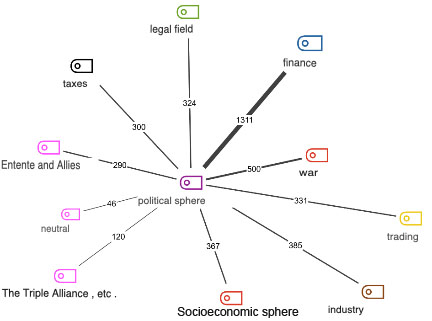
Fig. 9. Graph of co-occurrence frequencies for the category "political sphere" 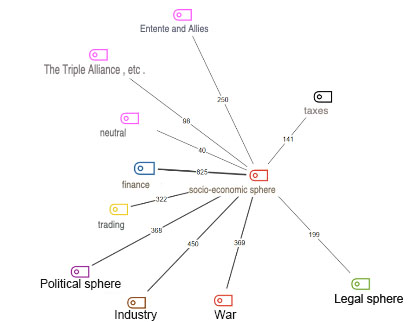
Fig. 10. Graph of co-occurrence frequencies for the category "socio-economic sphere" The categories "political sphere" and "finance" are closely connected. "War" takes the third place, lagging almost 2.5 times, and "industry" and "socio-economic sphere" are even more inferior. What is interesting: "trade" and "legal field" demonstrate smaller, but almost identical frequencies of joint occurrence with the central category in Fig. 9. According to the strength of the connection with the category "socio-economic sphere" (Fig. 10), "finance" is again far ahead of the rest, "industry" takes the second place, and "war" and "political sphere" share the third. Financial problems are also most relevant here. 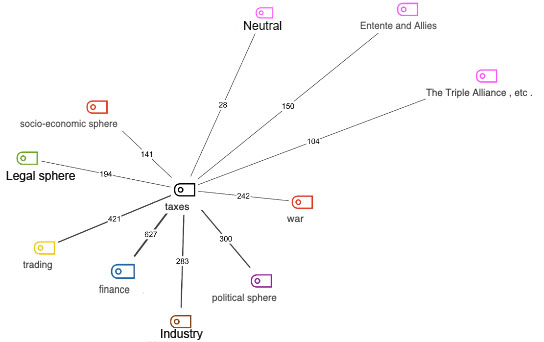
Fig. 11. Graph of co-occurrence frequencies for the "taxes" category The category "taxes" includes relevant issues of domestic and foreign taxation practice, as well as the history of the formation and prospects of customs duties. An important article is about planning tax reform. At the very beginning it says: "Currently, the shift of the center of gravity in taxation from indirect taxes to direct taxes is taking rapid steps. The importance of direct taxes is increasing, and at the same time the responsibility of tax inspectors is growing. Many new direct taxes have already been introduced, and several new ones are expected to be introduced in the near future" [17]. The frequency of joint occurrence with the category "finance" is the highest, followed by "trade", "political sphere" and "industry", and "war" is not so noticeable. Reforms are also overdue in the area of urban income distribution. Here is what I.M. Kulisher writes: "The Interim Government has approved a new law on urban finance. A reform has been carried out, which has been talked about for a number of years, which is caused by the urgent needs of city self-government bodies" [18]. 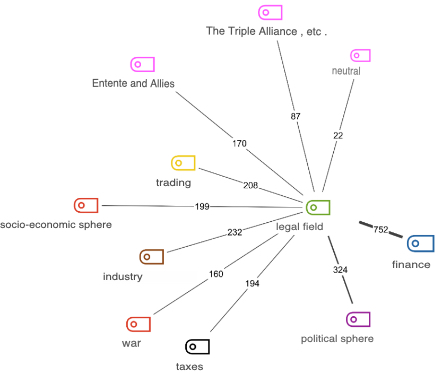
Fig. 12. Graph of co-occurrence frequencies for the category "legal field" And finally, the category "legal field". In the graph in Fig. 12, in the first place, as for the other categories, the connection of the "legal field" with "finance". The "political sphere" is much inferior, "industry", "trade", "socio-economic sphere" show frequencies even less. The "war" is less noticeable than even the "Entente and Allies". Why? The answer is in the very structure of the "legal field" category: the most important thing in it is not emergency laws and bills caused by military conditions, but, for example, the experience of codification of law in France and England. Here is a quote from L. S. Eliasson's article "Issues of codification of check law": "A complete coincidence between law and life can be stated in England and, perhaps, in France. In the first, where the check has reached the greatest distribution, where the popularity of the bank deposit has reached the limits of what is possible, and the law considers the check solely as a method of settlement. But even in France, the check law fully satisfies the needs of the environment for which it is intended, namely the most cultured part of the merchant class. To distribute a check to the people's lowlands, apparently, has never been pursued by banking policy in France" [19]. Analysis of the "countries" category We have built several pie charts that give an idea of the share of country mentions in the main semantic categories (Fig. 13-18): 
Fig. 13. The share of mentions of countries in the category "finance" 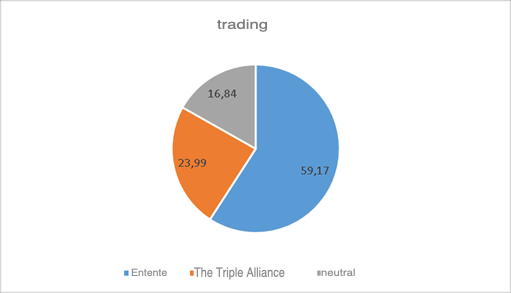
Figure 14. Shares of country mentions in the "trade" category 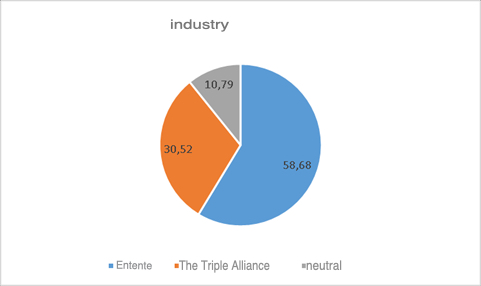
Fig. 15. The share of mentions of countries in the category "industry" 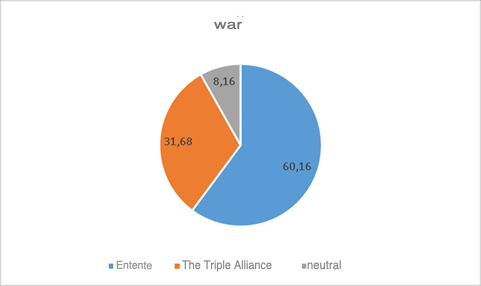
Fig. 16. The proportion of mentions of countries in the category "war" 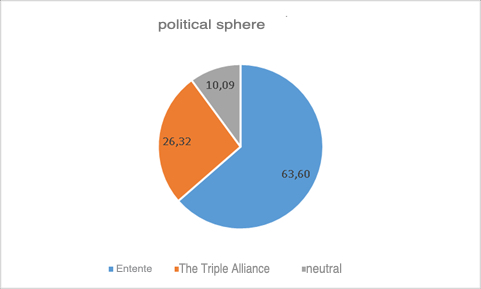
Fig. 17. The share of mentions of countries in the category "political sphere" 
Fig. 18. The share of mentions of countries in the category "socio-economic sphere" In each of the categories, the structure of which is presented in the diagrams, mentions of the Entente and allies are expected to prevail. But still it is possible to note some other features. So, within the "trade" category, neutral countries have a significant share (16.84%). This is not surprising, because in the conditions of military operations, in many respects it was the foreign trade turnover with them that made it possible to find new sources of financing for other sectors of the economy. At the same time, in conditions when any search for new forms of taxation to increase budget revenues became in demand, it is understandable that such a significant proportion of the countries of the opposing bloc – the Triple Alliance (36.88%) – appeared in the "taxes" category, apparently it was considered necessary to analyze the relevant practices of the enemy. In general, the same can be attributed to the category of "legal field": the analysis of legislative initiatives and bills in the camp of the enemy accounts for 31.18% of relevant publications, while the share of neutral countries is the smallest – 7.89%. In the "war" category, the share of the Triple Alliance and its supporters reaches 31.68%. In general, it cannot be said that the "enemy" is forgotten in other categories, on the contrary: in the already mentioned "trade" - almost 24% concern the enemy, in "finance" and even more – 27.82%, in the "political sphere" - 26.32%, in the "socio-economic" - 25.13%, and in the "industry" - more than 30%. All this testifies to the relentless attention on the pages of the "Bulletin ..." to the internal situation in the hostile camp. Diagrams are also constructed showing, on the contrary, the shares of the main semantic categories in the context of mentions of various blocks of countries (Fig. 19-21): 
Fig. 19. Structure of publication categories with references to the Entente 
Fig. 20. Structure of publication categories with references to the Triple Alliance 
Fig. 21. Structure of publication categories with references to neutral countries For the Entente and allies, "finance", "trade", "war" and "political sphere" come out on top. Here is a remarkable quote: "The main feature of the English stock market in 1916 is the fact that this activity remained within modest limits and did not distract the English population from the primary financial task - supplying the state with the necessary means for waging war" [20]. For the Triple Alliance, the main categories remain the same three, "industry" is promoted to the fourth place (you need to know and analyze the industrial potential of the enemy). In the very first quarter of 1917, a number of comments about the situation in Germany were found in the magazine: "Summing up our review, we can only repeat the opinion that has long been expressed that the war undoubtedly represents great material benefits for some segments of the German population, in particular, for holders of shares of enterprises, one way or another related to work for service" [20, p. 406]. There is also a contrast in this regard with the sitation in the Entente countries: "While in Germany the plan of financial mobilization and financial warfare has been developed by individuals and institutions for a number of years, served as the subject of detailed discussion, in the countries of consent, only occasional, isolated manifestations of interest in this problem can be noted" [21]. One can also see evidence of changes in Russia's domestic financial policy since the beginning of the war: "So, in addition to German and Austrian joint-stock companies admitted to operations in Russia, those Russian companies whose shares or management of affairs were in the hands of enemy subjects were also classified as "suspicious" [22]. In the context of reports about neutral countries, the most important category becomes, as we have already seen, "trade", followed by "finance" and "industry", and "war" closes the conditional four with 9.83%. About Sweden: "Taking advantage of the position of a neutral country, Sweden has significantly increased its exports to the belligerent countries" [23]. *** Let's note a small article in the tenth issue of the magazine, which is important for understanding the position of the publication in this crucial year. It is about the change in the political system of Russia as a result of the February Revolution: "What will and should be the role of our publication from now on? <...> We invite Russian economists, regardless of their direction and sympathies, to develop proposals and measures to promote the people's government. All reasoned and reasoned opinions to the best of their technical ability will find a place on the pages of our publication. At the same time, of course, we do not mean a political parliament of opinions (after all, the Bulletin of Finance is an economic body), but a discussion of topics by competent people, specialists who find out the truth from various points of view. Our publication will try to become not an exponent of one or another economic program, but a platform for the exchange of opinions, a laboratory for economic thought - of course, primarily not theoretical, but practical. We would be happy if the formulation and development of such currently important financial and economic issues on the pages of our publication would bring at least a small benefit to the renewing Russia."[3].
Certain conclusions can be drawn from the above quote. Firstly, the editorial board of the "Bulletin ..." quite predictably declares full commitment to the Provisional Government. Secondly, in this article there is a need to convince readers that the editors and employees have previously faced almost harassment. It is difficult to judge whether this was really the case, but this idea was inspired by the audience: "The editorial board of the Bulletin of Finance is proud that its staff includes prominent Russian scientists, economists and financiers of various currents of progressive political and economic thought. It was not easy for them sometimes when they had to lay down on a procrustean bed. It was also difficult for the editorial office to defend useful and talented works from departmental influences. But, due to the absence of independent economic press bodies in Russia, both employees and editorial staff had to put up with the state of affairs." [24, p. 453]. The editorial notes are contained in several more articles of the "Bulletin ...", but the one discussed above most clearly expresses the position of the editorial board of the journal. Frequency analysis in this case is supplemented by a detailed reading – close reading– of the source text. Conclusion "Bulletin of Finance, Industry and Trade" is a valuable historical source with a high potential for research and increasing information returns. The computerized content analysis allowed to reveal not only the explicit, but also the hidden layer of information contained in this journal. Despite the fact that, ultimately, the interpretation of the research results is in a certain sense subjective and conditioned by the formulation of the research task, there is no doubt that the text reflects the source of extra-textual reality. The system of semantic categories built on the basis of the full-text database of journal articles made it possible to supplement the set of headings of the "Systematic Lists" of the journal, as well as the set of keywords, sections and subsections proposed in the bibliographic database in the work of A. K. Kirillov and V. S. Terentyev in 2005 [3] Semantic categories and their indicators make it possible to get an idea of the semantic accents in the journal materials. The content analysis of Vestnik... made it possible to identify priority thematic categories, which included journal articles, to conduct a frequency analysis of the occurrence of these categories in dynamics by quarter, to consider the relationship of categories through the frequency of their joint occurrence. The interrelationships of categories reveal the argumentation of the authors of articles when covering topics that attracted their attention. The conducted content analysis of the leading printing body of the Ministry of Finance showed that the "Bulletin ..." reflected the problems of the socio-economic sphere in Russia and abroad that matured during the First World War. Throughout the year, the "finance" category remained the main one, its links with others in terms of the frequency of joint occurrence are the strongest. "Trade" takes the second place in the first two quarters. In the third quarter, the picture changes: the "industry" category comes in second place, and the "political sphere" and "war" divide the third. In the fourth quarter, as we know, the magazine ceased to exist. Nevertheless, a number of conclusions can be drawn: "finance" is in the first place here, but "war" comes next, and the "political sphere" closes the top three. Moreover, when studying the relations of the category "war", an unexpected fact was discovered, which, if traditional methods of analysis were used, would have gone unnoticed: a strong connection with the category "finance" has already been noted, but the links with the categories "industry", "political sphere" and "trade" turned out to be noticeably stronger than even with the opposing blocs of states not to mention neutral countries. Thus, the main thing for the coverage of the military sphere on the pages of Vestnik ... was, first of all, its financial content, as well as political stability, industrial and trade potential of the country in war conditions, and not alliance or confrontation within the respective blocs. The results of the content analysis show that the pages of the magazine reflected the economic processes in Russia in 1917 in the conditions of the ongoing war. The stable core of the semantic category system was, on the one hand, financial issues related to industry, trade, taxes, on the other hand, political and social problems, since the war put Russia on the verge of financial bankruptcy and social explosion. The opinion of the editorial board of the magazine on the revolutionary events of 1917 is also important, expressed in the article "From the editorial Board", small in volume, but important in content (that's why we analyzed it in detail). The editorial policy is presented as devoid of neutrality. On the contrary, as already noted, there are signs of a positive coloring of statements about the February Revolution, the desire to give emotionality to the formulations, and, on the contrary, condemnation of autocracy. This suggests that the leadership of Vestnik... in this case solved a twofold task: to demonstrate loyalty to the authorities in the new conditions and indirectly propagandize the corresponding political line among readers.
References
1. Garskova, I. M. (2018). Историческая информатика: эволюция междисциплинарного направления [Historical Information Science: Evolution of Interdisciplinary Field]. Saint Petersburg, Russia: Aleteya, 292-308.
2. Zaichenko, A. N. (2013). Economic Processes in Austria-Hungary in “Herald of Finance, Industry and Commerce” Pages in 1906. Исторические, философские, политические и юридические науки, культурология и искусствоведение. Вопросы теории и практики, 3(29), 107–110.
3. Kirillov, A. K. (2006). Электронная публикация исторических источников: проблемы и перспективы (на примере Вестника финансов, промышленности и торговли за 1917 год) [Electronic Publishing of the Historical Sources: Problems and Perspectives (by the Example of the “Bulletin of Finance, Industry and Trade” for 1917).]. История Сибири, 1583–2006. Проблемы и перспективы: Сборник материалов региональной молодёжной научной конференции, 14–19. Novosibirsk, Russia: Owl Publishing House.
4. Kirillov, A. K. (2017). From the Poll Tax to Income Tax: Tax Reforms of Capitalistic Russia and Their Implementation in Western Siberia in the second half of the XIX – early XX century. Novosibirsk, Russia: Parallel.
5. Kostrikov,S. S. & Kostrikov, S. P. (2023). Источники коммерческой и политической информации Министерства финансов царской России (начало ХХ вв.) [Sources of Commercial and Political Information Ministry of Finance of Tsarist Russia (The Beginning of the XX Century).]. Вопросы фундаментальных и прикладных научных исследований: сборник статей международной научной конференции, 6–8. https://doi.org/10.37539/230310.2023.17.34.005
6. Salomatina, S. A. (2023). Банковский кризис 1880-х гг. в Российской империи: новые количественные данные и оценки [Banking Crisis of the 1880s in the Russian Empire: New Quantitative Data and Estimates]. Исторический журнал: научные исследования, 1, 85–108. Retrieved from https://doi.org/10.7256/2454-0609.2023.1.39571
7. Kitanina, T. M. (2016). Россия в Первой мировой войне 1914-1917: экономика и экономическая политика. Курс лекций [Russia in the First World War 1914-1917: Economy and Economic Policy: Cource of Lectures]. Saint Petersburg, Russia: Academia of the Humanities.
8. Полное собрание законов Российской империи. (1887). [Complete Collection of Laws of the Russian Empire]. 3, V, 13. Retrieved from https://runivers.ru/lib/book3139/9998/
9. «Необходимые сведения в возможно удобной форме...» [“The Necessary Information in a Much More Convenient Form…”]. Retrived from https://bujet.ru/article/7131.php?sphrase_id=24395504
10. MAXQDA: The Art of Data Analysis. Retrieved from https://maxqda.com/about
11. Voronkova, D. S. (2018). Вестник финансов, промышленности и торговли за 1917 г. как источник для изучения экономического развития России: тематика и авторы статей журнала [“Bulletin of Finance, Industry and Trade” for 1917 as a Source for Examine of the Economic Development of Russia]. Исторический журнал: научные исследования, 3, 148–162.
12. Voronkova, D. S. (2020). Количественный анализ журнала Вестник финансов, промышленности и торговли за 1913 г.: авторы и тематика статей [Quantitative Analysis of the “Journal of Finance, Industry and Trade” for 1913: Authors and Discussed Topics]. Исторический журнал: научные исследования, 4, 54–73. Retrieved from https://doi.org/10.7256/2454-0609.2020.4.33722
13. Voronkova, D. S. (2020). Сравнительный анализ тематики публикаций журнала Вестник финансов, промышленности и торговли за 1913 и 1917 гг [Comparative Analysis of the Thematic Focus of the Publications of the “Journal of Finance, Industry and Trade” for 1913 and for 1917]. Исторические исследования в контексте науки о данных: информационные ресурсы, аналитические методы и цифровые технологии. Материалы международной конференции. Москва, 4–6 декабря 2020 г. Moscow, Russia: Maks Press, 25–32.
14. Remez, B. (1917). Денежная реформа и развитие производительных сил [Monetary Reform and the Development of the Productive Forces]. Вестник финансов, промышленности и торговли, 9, 396.
15. Gur’ev, A. N. (1917). Опыт анализа и решения финансовой проблемы [Experience of Analysis and Solution of Financial Trouble]. Вестник финансов, промышленности и торговли, 39, 362.
16. Rapoport, S. I. (1917). Строительство будущей экономической жизни в Великобритании [Development of the Future Economic Life in Great Britain]. Вестник финансов, промышленности и торговли, 43, 514.
17. Poliuta, E. (1917). К реформе промыслового обложения [For Reform of the Commercial Taxation]. Вестник финансов, промышленности и торговли, 30, 92.
18. Kulisher, I. I. (1917). Реформа городских финансов [Reform of the City Finances]. Вестник финансов, промышленности и торговли, 40, 403.
19. Eliyasson, L. S. (1917). Вопросы кодификации чекового права [Issues of the Codification of Cheque Law]. Вестник финансов, промышленности и торговли, 23, 394.
20. Kan, R. (1917). Европейские биржи в 1916 г. [European Exchanges in 1916]. Вестник финансов, промышленности и торговли, 9, 406.
21. Levin, I. I. (1917). Военные займы во Франции [War Bonds in France]. Вестник финансов, промышленности и торговли, 13-14, 607.
22. A. V. (1917). Законодательство о предприятиях неприятельских подданных [Legislation about Enterprises of the Enemy Aliens]. Вестник финансов, промышленности и торговли, 10, 461.
23. Shatenshtein, V. (1917). Теория и практика денежного обращения [Theory and Practice of the Monetary Circulation]. Вестник финансов, промышленности и торговли, 1, 7.
24. От редакции (1917). [From the Editorial Office]. Вестник финансов, промышленности и торговли, 10, 453.
Peer Review
Peer reviewers' evaluations remain confidential and are not disclosed to the public. Only external reviews, authorized for publication by the article's author(s), are made public. Typically, these final reviews are conducted after the manuscript's revision. Adhering to our double-blind review policy, the reviewer's identity is kept confidential.
The list of publisher reviewers can be found here.
Review of the article "The experience of computerized content analysis of articles of the journal "Bulletin of Finance, Industry and Trade" for 1917. The subject of the study is indicated in the title and explained in the text of the article. Research methodology. The author notes that he used the method of content analysis, a method recognized as promising in conducting historical, sociological and other research. The content analysis method examines newspaper, magazine, scientific and other texts, Internet news resources and much more. Content analysis is one of the most widely used methods by researchers when analyzing a large number of materials. The novelty of the material is due to the formulation of the problem and tasks. The novelty also lies in the fact that the author of the reviewed article conducted a content analysis of the journal "Bulletin of Finance, Industry and Trade", previously the materials of this journal had not been studied by the content analysis method. The content analysis of the journal articles was carried out using the MAXQDA program, which can create variables for the analyzed texts. Style, structure and content. The style of the article is scientific, but there are elements of the popular science style and this makes the article understandable to a wider range of readers. The structure of the article is aimed at achieving the purpose and objectives of the article. The article consists of a small introductory part and the following sections: "Bulletin ..." as a source; Research methodology; Development of a system of categories and analysis of their occurrence frequencies; Analysis of the frequency of joint occurrence of categories; Analysis of the category "countries"; Conclusion. The section names correspond to the content. The author explains the research methodology, purpose and objectives. According to the content of the article, he identified the most common articles and identified indicators based on them. Then the indicators were consolidated into a system of categories. Then the text was indexed using the auto-encoding option with a dictionary. The author explains that "indexing in content analysis is the markup in the text of segments where indicators of the corresponding categories occur. Indexing was based on indicators for which only the root bases of words were set." In total, the author identified 14 categories: finance, trade, industry, war, political sphere, socio-economic sphere, taxes, legal field, agriculture, joint-stock business, transport, mail and telegraph, resettlement policy, countries. The author notes that all these categories "with the exception of the category of "countries" are single-level, and the latter includes warring and neutral states, and the composition of the corresponding blocks was formed taking into account the realities of 1917, therefore, for example, Italy turned out to be on the side of the Entente)." He also highlighted the most important issues that the magazine covered and analyzed their topics. The content of the article is logically structured, consistently stated and aimed at achieving goals and objectives. The text of the article contains 1 table and 21 figures, which gives the reader the opportunity to better understand the text of the article. In conclusion, the author notes that "the results of the content analysis show that the pages of the magazine reflected the economic processes in Russia in 1917 under the conditions of the ongoing war. The stable core of the semantic category system was, on the one hand, financial issues related to industry, trade, taxes, on the other hand, political and social problems, since the war brought Russia to the brink of financial bankruptcy and social explosion." In addition, the content analysis also revealed the position of the editorial board of Vestnik.., which was not neutral and, in the opinion of the author of the article, "solved a twofold task: to demonstrate loyalty to the authorities in the new conditions and indirectly promote the appropriate political line among readers." The bibliography of the article contains 24 sources, the bibliography is diverse and fully gives readers an idea of both content analysis, as a method of historical research, and the situation that developed in 1917. The bibliography shows that the authors of the article are well versed not only in the topic under study, but also in related topics. The appeal to the opponents is presented at the level of information collected during the work on the topic of the article. The appeal to the opponents is presented in the bibliography, in which you can find answers to your questions. The article is written on an interesting topic, the content analysis of the journal "Bulletin of Finance, Industry and Trade" for 1917 shows that content analysis provides ample opportunities for analyzing journal materials and it seems that this will contribute to the further development of this method in historical research. The article will be of interest to specialists and a wide range of readers (students, undergraduates, postgraduates).
Link to this article
You can simply select and copy link from below text field.
|
|




